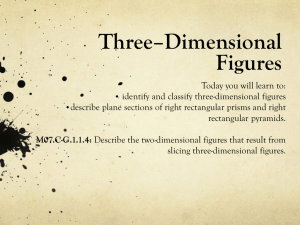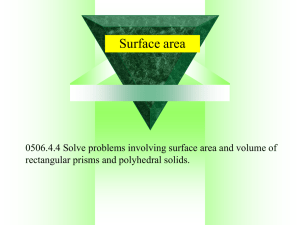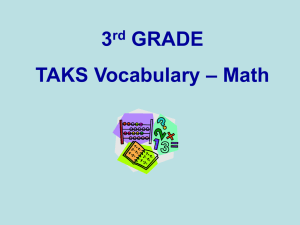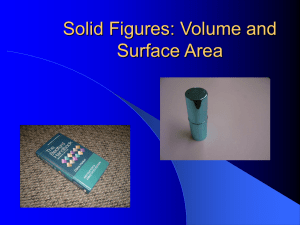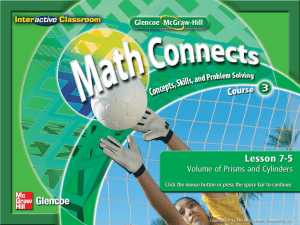3D objects lesson 2
advertisement
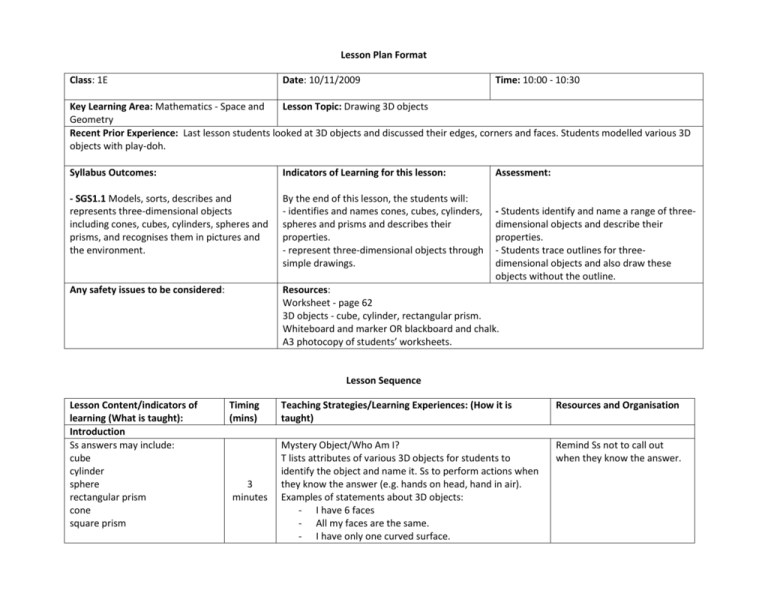
Lesson Plan Format Class: 1E Date: 10/11/2009 Time: 10:00 - 10:30 Key Learning Area: Mathematics - Space and Lesson Topic: Drawing 3D objects Geometry Recent Prior Experience: Last lesson students looked at 3D objects and discussed their edges, corners and faces. Students modelled various 3D objects with play-doh. Syllabus Outcomes: Indicators of Learning for this lesson: Assessment: - SGS1.1 Models, sorts, describes and represents three-dimensional objects including cones, cubes, cylinders, spheres and prisms, and recognises them in pictures and the environment. By the end of this lesson, the students will: - identifies and names cones, cubes, cylinders, spheres and prisms and describes their properties. - represent three-dimensional objects through simple drawings. Any safety issues to be considered: Resources: Worksheet - page 62 3D objects - cube, cylinder, rectangular prism. Whiteboard and marker OR blackboard and chalk. A3 photocopy of students’ worksheets. - Students identify and name a range of threedimensional objects and describe their properties. - Students trace outlines for threedimensional objects and also draw these objects without the outline. Lesson Sequence Lesson Content/indicators of learning (What is taught): Introduction Ss answers may include: cube cylinder sphere rectangular prism cone square prism Timing (mins) Teaching Strategies/Learning Experiences: (How it is taught) Resources and Organisation Remind Ss not to call out when they know the answer. 3 minutes Mystery Object/Who Am I? T lists attributes of various 3D objects for students to identify the object and name it. Ss to perform actions when they know the answer (e.g. hands on head, hand in air). Examples of statements about 3D objects: - I have 6 faces - All my faces are the same. - I have only one curved surface. Ss identify 3D objects based on their properties. - Development A cube has 6 faces, which are shaped as a square. Ss describe properties of threedimensional objects. Ss lists the steps needed to draw 3D objects. A cylinder has 2 faces and 1 curved surface. A rectangular prism has 6 faces which are shaped as a rectangle. 25 minutes I have a curved surface which meets at a point. I have two ends which are circles and one curved surface. Looking at the worksheet, what is the first object on the sheet? How many faces does this object have? What is the shape of each face? Ss use their pointers to draw a square. T: The first thing we need to do to draw a cube is draw a square - draw square on board. Again Ss draw a square using their pointers. To make this two-dimensional square a three-dimensional cube we: - First draw a square (draw over square on board). - Second, draw a second square behind the first one. - Then we connect the matching corners. Have Ss hold up their left hand, their right hand. Ss to point to the top and bottom. - So, you have to connect the top left corner of the first square with the top left corner of the second square. (Repeat with other corners). Using enlarged A3 worksheet, demonstrate the above procedure with the dotted outline of the cube. Quiz students about the order of the steps. Once Ss have traced the first shape, look at the second 3D object. What is the object? How many faces does it have? It has one curved _____? To draw a cylinder: - Draw a circle. - Draw another circle below it. - Draw two lines from the outsides of the circles. Using enlarged A3 worksheet, demonstrate the above procedure with the dotted outline of the cylinder. Quiz students on the order of steps for drawing a cylinder. Look at the third object on the worksheet. What is the object? How many faces does it have? What is the shape of the faces? Drawing a rectangular prism is very similar to drawing a Have book monitors hand out worksheets to students at their desks. Remind Ss to put their names and date on their sheet. Pencils down, pointers only at this point. Ss to follow demonstration with their pointers. Ss to follow on their worksheet and draw the lines that T draws. Ss to draw on their worksheets, tracing the outline. cube. Who can tell me what we might do differently? steps for drawing a rectangular prism: - Draw a rectangle. - Draw a second rectangle behind the first one. - Connect the matching corners. Using enlarged A3 worksheet, demonstrate the above procedure with the dotted outline of the rectangular prism. Quiz students on the order of steps for drawing a rectangular prism. Ss are to return to the top of the sheet and trace over the shapes already completed. Ss are to then attempt to draw the shape on the next outline working their way down the sheet. When finished Ss can turn their page over and try drawing cubes, cylinders and rectangular prisms by themselves. Explain to Ss that the T will write the steps for drawing these objects on the board if they need reminding. Closure Ss represent 3D objects through air drawing. 3 minutes Recap with Ss the order for drawing cubes, cylinders and rectangular prisms. While going through steps, Ss draw objects with their pointers. Ss to re-trace in a different colour Book monitors to collect sheets and place on the marking table.


